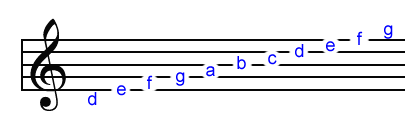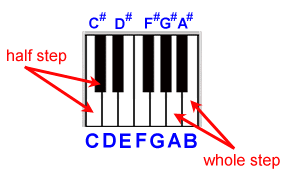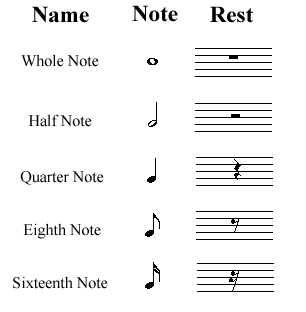Theory 1 Intervals
Well, where do I begin? How about the beginning. First of all, there are only twelve notes in the entire world. That is assuming you’re not from India, where they have twenty four. The “musical alphabet” as I call it, is A through G, just like the regular alphabet, except when you get to G you go back to A. There is no H. All the flats and sharps are in between. As you go up in pitch, you are going forwards in the alphabet. As you go down in pitch, you are going backwards in the alphabet. Have you ever heard the phrase ” Every Good Boy Does Fine?” Maybe, maybe not. Beginning music readers use this as a tool to remember the names of the notes that appear on the lines of the staff with the treble clef. The first letter of each word spells E – G – B – D – F. The notes in the spaces spell something you look at every day: F – A – C – E. If you put them all together, it looks like this:

The smallest increment in Western music is the half step. It is the distance between one note and an adjacent note, either up or down. To flat a note means to lower it by a half step. To sharp a note means to raise it a half step. The keyboard below shows the location of all twelve notes. The white notes are the key of C, no flats or sharps. The flats and sharps are the black notes.

That brings us to the subject of intervals. Here are the general names for intervals in a major scale. I have these listed using letter names and numbers. The scale steps are frequently referred to as numbers 1 through 7. They are usually Roman numerals. Using numbers is more convenient because it is the same no matter what key you happen to be in. Note that there is no such interval as a major or minor fourth or fifth. They are called perfect intervals.
Here they are in the key of C:
Using Letter Names | Using Roman Numerals |
|
|
Here are the names of intervals for the chromatic scale: | |
|
| |
Enharmonic equivalent is another way of saying that each note has two names. For example, the note E flat can also be called D#. The interval between C and E flat can be called either a minor third or an augmented second, the interval is the same. However, it is considered more correct to call it a minor third because the general name is first and foremost a third. If you flat the interval (make it minor), of the third, then you have a minor third. A C to D# would be more accurately called an augmented second because the general name is a second. Another example would be A C to an A would be a sixth and because it is in the C major scale it would be called a Major sixth.
Tips on Reading Music |
There are two basic criteria to consider when learning how to read music. Pitch and rhythm. Pitch is determined by the placement of the note in the staff. Rhythm, or the duration of the note, is determined by the kind of note it is. I will deal with the five most common notes first. They are: whole notes, half notes, quarter notes, eighth notes and sixteenth notes. Every note has a corresponding rest with equal value. In common (four-four) time, whole notes and whole rests get four beats. Half notes and half rests get two beats. Quarter notes and quarter rests get one beat. Eighth notes and eighth rests get a half beat (or, two eighths per beat). Sixteenth notes and sixteenth rests get a quarter of a beat (or, four sixteenths per beat).
| |||






